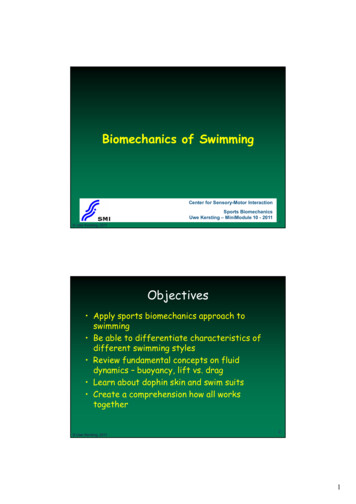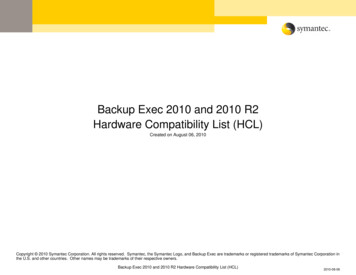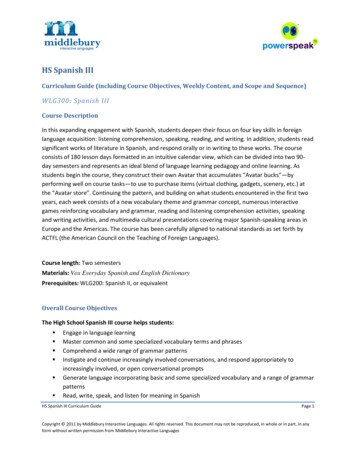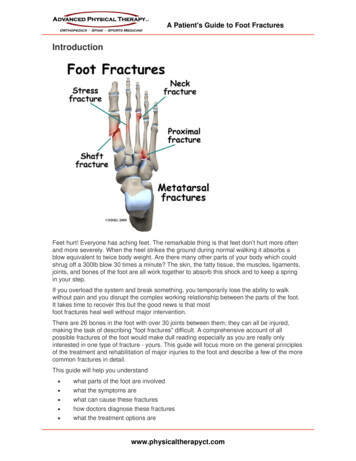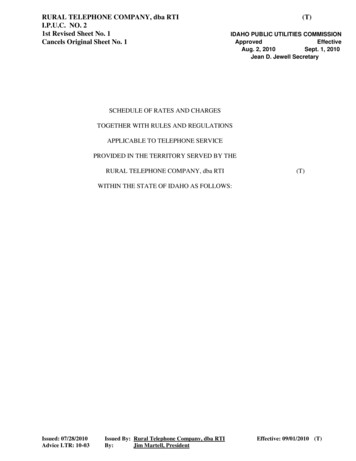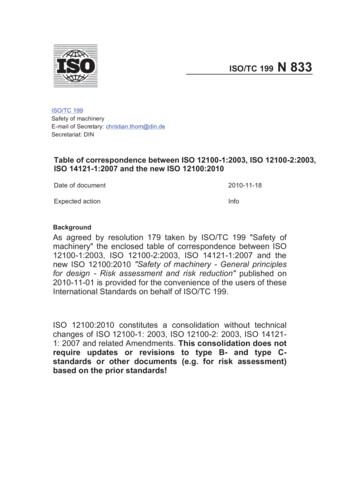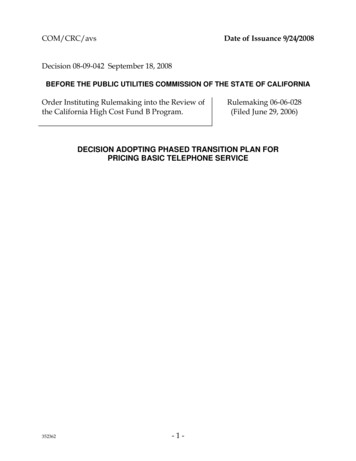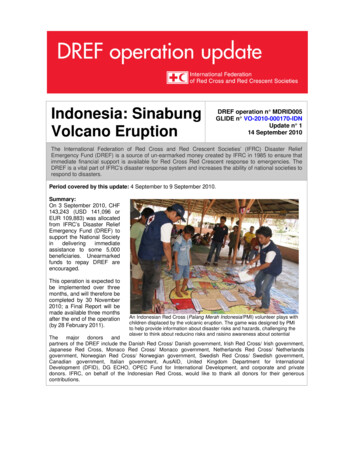
Transcription
Indonesia: SinabungVolcano EruptionDREF operation n MDRID005GLIDE n VO-2010-000170-IDNUpdate n 114 September 2010The International Federation of Red Cross and Red Crescent Societies’ (IFRC) Disaster ReliefEmergency Fund (DREF) is a source of un-earmarked money created by IFRC in 1985 to ensure thatimmediate financial support is available for Red Cross Red Crescent response to emergencies. TheDREF is a vital part of IFRC’s disaster response system and increases the ability of national societies torespond to disasters.Period covered by this update: 4 September to 9 September 2010.Summary:On 3 September 2010, CHF143,243 (USD 141,096 orEUR 109,883) was allocatedfrom IFRC’s Disaster ReliefEmergency Fund (DREF) tosupport the National Societyindeliveringimmediateassistance to some 5,000beneficiaries. Unearmarkedfunds to repay DREF areencouraged.This operation is expected tobe implemented over threemonths, and will therefore becompleted by 30 November2010; a Final Report will bemade available three monthsafter the end of the operation(by 28 February 2011).An Indonesian Red Cross (Palang Merah Indonesia/PMI) volunteer plays withchildren displaced by the volcanic eruption. The game was designed by PMIto help provide information about disaster risks and hazards, challenging theplayer to think about reducing risks and raising awareness about potentialThemajordonorsandpartners of the DREF include the Danish Red Cross/ Danish government, Irish Red Cross/ Irish government,Japanese Red Cross, Monaco Red Cross/ Monaco government, Netherlands Red Cross/ Netherlandsgovernment, Norwegian Red Cross/ Norwegian government, Swedish Red Cross/ Swedish government,Canadian government, Italian government, AusAID, United Kingdom Department for InternationalDevelopment (DFID), DG ECHO, OPEC Fund for International Development, and corporate and privatedonors. IFRC, on behalf of the Indonesian Red Cross, would like to thank all donors for their generouscontributions.
The situationA volcano that was dormant for more than 400 years shot a powerful burst of volcanic ash into the air onFriday, 28 August 2010, catching scientists off guard and sending residents returning home after an earlierevacuation fleeing yet again. By 30 August, some 25,000 people had been displaced.It again erupted on the night of 7 September, throwing ash and rocks into the air; some small rocks reachedmore than 7 km distance from the volcano. The blast released was the most powerful one yet. The eruptionlasted for 13 minutes, sending a column of ash as high as 5,000 meters into the air. A governmentvolcanologist explained that there had been “intense magma movement” inside the volcano since 2September.After several days of calm following the initial eruption, villagers began returning to their homes over theweekend. However, with this renewed eruption, many of these villagers have returned to the safety of thedisplaced shelters.The Mount Sinabung in North Sumatra eruptions are mainly formed of ash and smoke but there have beenwarnings that this could be a precursor to more earthquakes and volcanic eruptions in the region. Thevolcano alert centre continues to monitor the situation 8 km away from Mount Sinabung’s base.Indonesia sits on a series of fault lines running through Southeast Asia up to Japan known as the Ring ofFire because of the frequency of seismic activity. The most famous eruption occurred in 1883, when MountKrakatau blew its top, changing weather patterns around the world in one of the worst-ever volcanicexplosions.As at 8 Sept 2010, according to the National Disaster Management Agency (Badan NasionalPenanggulangan Bencana/BNPB), 27,489 displaced people from eight sub-districts have been evacuatedand are living in 22 Jambur (Karonese Wedding Hall) and churches adapted into camps. As these peopleare displaced in a short period and it is uncertain when they will be able to return to their houses, emergencyrelief and assistance is still urgently needed to improve the health and hygiene status of those displacedfamilies.Government’s responseIn response to the Sinabung volcano eruption, the Indonesian government through BNPB allocated IDR1,500,000,000 for the management of internally displaced people (IDP) camps in Karo district. These fundswill be used for food and medical supplies as needed and also to ensure security in all affected areas. Inaddition to this, BNPB has distributed 1,000 blankets, 1,000 sleeping mats and 500 family tents. The localgovernment has allocated 50 tonnes of rice, 14,000 tins of fish, 1 water truck, 1,000 bottles of ketchup, 240kg of instant noodles, 500 blankets, 50 family tents, 200 sleeping mats, oxygen bottles/tubes for emergency,and 5,000 packs of vitamin C and B6.The ministry of health has also distributed 36.000 masks and 2,000 rubbish bins. The social department hasestablished public kitchens in four IDP camps, while the provincial district health office of North Sumatra isproviding health services. The ministry of transportation has requested all transportation agencies (airwaysand land transportation) to prioritize delivery of goods and people to support the Sinabung emergencyoperation. The ministry of public works will try to address the need of latrines and bathing by mobilizing waterand sanitation equipment and tools from North Sumatra, and also from Jakarta (in Java), Padang, and Acehif required.The local military forces (TNI and POLRI) have mobilized 486 TNI personnel and 378 POLRI personnel tohelp provide security and protection of the displaced families homes, live stock, crops and belongings whichthey left at their houses and villages.After the visit of the president of Indonesia to Kabanjahe, the government distributed IDR 3,000,000,000 toorganizations in the field (such as TNI, POLRI and the Kabupaten local government) and plans to reallocatethe beneficiaries in new camps closer to their villages. These funds are to be used for the preparation of thenew camps’ shelter facilities.
Coordination and partnershipsPMI continue to will work and conduct all activities under this programme in collaboration with other agenciesthat may also be planning on supporting communities in these same locations. PMI is already a keyparticipant and informant in the government-led coordination system and is also a member of theinteragency assessment team since the onset of this disaster. PMI is also an active partner in the nationaldisaster response network that coordinates emergency responses between the government ministries,forces, private sector, UN and NGO agencies.Red Cross Red Crescent actionPMI continues to support the affected communities. There are 43 volunteers active in the field:No1PMI Kabupaten/TownPMI Kota MedanVolunteers923.PMI LangkatPMI Kota Binjai7945.6.78.PMI Labuhan BatuPMI Kota SibolgaPMI Deli SerdangPMI Tanah KaroPMI North Sumatra province2174443FunctionAssessment, information, psychosocialsupport programme (PSP),ambulance/medical action team (MAT),logisticsMobile kitchen, ambulance/MATCoordination, mobile kitchen,administrationAssessment, PSPWater and sanitationRelief distribution, PSPAdministration, support Poskos (post)Coordination, administration, 2 doctorsThe plans on the response are finalized and will follow with current activities, setting up field kitchens,providing more emergency latrines and water tanks, locating rubbish bins and maintaining health services inJambur Guru Pulungan. PSP is still focusing on the children in the camps. Meanwhile, the volunteers areconducting assessments on aid distribution to support the logistics team in distributing relief items.Progress towards objectivesThe operation will provide immediate relief and assistance for evacuated families sheltered under evacuationhalls. Funds will be prioritized for provision of non-food and food items, and the replenishment of stockalready distributed from PMI warehouses for potential disasters such as this.PMI will support 5,000 most vulnerable affected people mainly from the following sub-districts:1. Naman Teran2. Sinpang Empat3. Payung4. TiganderketPMI have been leading the joint agency assessment activities in many of the 22 displaced camps and othershelter locations which presently house more than 27,000 individuals. Although relief is being provided bythe government to some of these displaced there are still many individuals that have not yet been providedwith even the minimal relief items. PMI has exhausted its contingency stocks in an effort to cover some ofthese needs. It has identified at least 5,000 beneficiaries that still require urgent relief items which include: face masks hygiene kits Water and sanitation materials (e.g. jerry cans, brooms, buckets, mops, cleaning liquids etc.), Blankets Rope Plastic sheeting Sleeping mat Baby Kits Other identified and necessary relief items not being supplies by other agencies.
Relief distributionsOutcome: 5,000 of the most affected and displaced people are supported with essential non-fooditems to meet their immediate needs.Expected results:5,000 most affected and displaced people affected by the volcano eruption receive non-food assistance.Activities planned Identify and register most affected and displaced families based on agreed criteria; Distribute non-food items from existing stocks to identified beneficiaries; Continuously monitor relief activities and provide reporting on relief distributions; Conduct an ongoing assessment of the impact of the flood and review support strategies; Conduct an impact evaluation; Replenishment of stocks based on approved budgets and IFRC procurement requirement.ProgressData on relief distributions is being compiled and will be detailed in the next update.Emergency FoodOutcome: 5,000 of the most affected and displaced people are supported with essential food itemsto meet their immediate needs.Expected results:Emergency food is provided and where necessary cooked to provide 5,000 displaced people with a dailyration of meals while they remain displaced and sheltered in refuge halls.Activities planned: A mobile public kitchen will be operated in locations where families have fled the volcano but havenot received any assistance from the authorities or other relief service; Food support will be provided in coordination with other food providers to individuals who havebeen neglected or where insufficient assistance has been provided.ProgressThe mobile kitchen team continues to support displaced people in Singgamanik camp, preparing food andporridge for more than 500 people in the camp twice daily.Emergency healthOutcome: The psychological disturbance and health risk has been reduced through psychologicalsupport and mobile clinics.Expected results:Emergency health services rendered to 5000 displaced people.Activities planned: Rendering psychosocial support;Conducting children activities /games; Provision of psychosocial counselling services; Conduct support groups for women, elderly and other people that may have been traumatized bythis event; Mobile public clinic operating for families who have fled the volcano.ProgressThe health/mobile clinic teams continue to provide emergency health services to the displaced people. SomeIDPs are still being treated for respiratory and psychosomatic problems. An estimated 150 people benefitdaily from the mobile ambulance service.
The PSP team is supporting children in Singgamanik Camp at Tiga Binanga sub-district, with more than 30children participating in the games created by the PSP team. These games are developed to provideinformation about disaster risks and hazards.Assessments are ongoing to identify further needs. All IDP locations have already been assessed at leastonce. The most common treatments are for diarrhoea and gastrointestinal diseases. An increase in mosquitobites has been observed at the camps and an assessment on the risk of malaria in these areas is beingplanned.Water, sanitation, and hygiene promotionOutcome: To assist 5,000 people most affected and displaced people affected by the Sinabungvolcano eruption to reduce health risks through improvement in the sanitation environment.Expected results:Hygiene environment and facilities improved for the displaced persons.Activities planned: Building materials to construct temporary latrines and bathing facilities; Cleaning and upkeep of drainage; Improvement of rain protection measures; Provision of garbage collection facilities.ProgressThe water and sanitation team has constructed two latrines and two water tanks in GBKP Klasis camp andtwo water tank in Guru Pulungan camp. They are also distributing dust bins and performing communitysocialization on garbage management and cleaning.
How we workAll International Federation assistance seeks to adhere to the Code of Conduct for theInternational Red Cross and Red Crescent Movement and Non-Governmental Organizations(NGOs) in Disaster Relief and the Humanitarian Charter and Minimum Standards in DisasterResponse (Sphere) in delivering assistance to the most vulnerable.The International Federation’s vision is toinspire, encourage, facilitate and promote at alltimes all forms of humanitarian activities byNational Societies, with a view to preventingand alleviating human suffering, and therebycontributing to the maintenance and promotionof human dignity and peace in the world.The International Federation’s work is guided byStrategy 2020 which puts forward three strategicaims:Save lives, protect livelihoods, and strengthenrecovery from disaster and crises.Enable healthy and safe living.Promote social inclusion and a culture of non-violenceand peace.Contact informationFor further information specifically related to this operation please contact:Indonesian Red Cross (PMI): Mrs. Aswi R. Nugroho, head of communications division; email: reksaningtyas@yahoo.com;phone: 62 21 799 2325 ext. 221; fax: 62 21 799 5188Federation country office in Indonesia: Wayne Ulrich Disaster management coordina
A volcano that was dormant for more than 400 years shot a powerful burst of volcanic ash into the air on Friday, 28 August 2010, catching scientists off guard and sending residents returning home after an earlier evacuation fleeing yet again. By 30 August, some 25,000 people had been displaced. It again erupted on the night of 7 September, throwing ash and rocks into the air; some small rocks .
